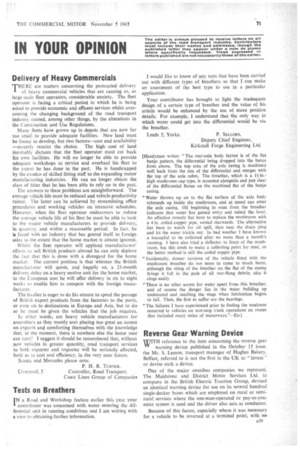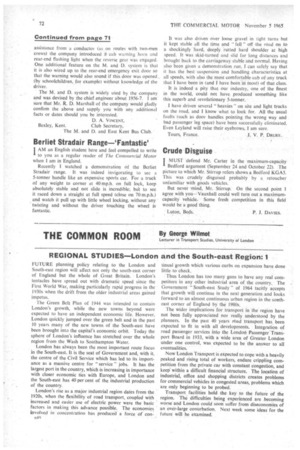IN YOUR OPINION
Page 73

Page 74

If you've noticed an error in this article please click here to report it so we can fix it.
Delivery of Heavy Commercials
THERE are matters concerning the protracted delivery of heavy commercial vehicles that are causing us, as large-scale fleet operators, considerable anxiety. The fleet operator is facing a critical period in which he is being asked to provide economic and efficent services whilst overcoming the changing background of the road transport industry caused, among other things, by the alterations in the Construction and Use Regulations.
Many fleets have grown up in depots that are now far too small to provide adequate facilities. New land must be found to develop, but two factors—cost and availability —severely restrict the choice. The high. cost of land inevitably dictates that the fleet operator must cut back his own facilities. He will no longer be able to provide adequate workshops to service and overhaul his fleet to the extent he has done in the past. He is handicapped by the exodus of skilled fitting staff to the expanding motor manufacturing industries. He can no longer obtain the class of fitter that he has been able to rely on in the past.
The answers to these problems are straightforward. The average vehicle life must be reduced and vehicle productivity raised. The latter can be achieved by streamlining office procedures and working vehicles on intensive schedules. However, when the fleet operator endeavours to reduce the average vehicle life of his fleet he must be able to look to the major vehicle manufacturers to provide delivery, In quantity, and within a reasonable period. In fact, he ii faced with an industry that has geared itself to foreign sales to the extent that the home market is almost ignored.
Whilst the fleet operator will applaud manufacturers' efforts to sell British products abroad he can only deplore the fact that this is done with a disregard for the home market. The current position is that whereas the British manufacturer will quote, and happily so, a 21-month delivery delay on a heavy motive unit for the home market, to the European user he will offer delivery in six to eight weeks to enable him to compete with the foreign manufacturer.
The haulier is eager to do his utmost to speed the passage of British export products from the factories to the ports, or even on to destinations in Europe and Asia, but to do so he must be given the vehicles that the job requires.
In other words, are heavy vehicle manufacturers (or assemblers as they mostly are) placing too great an accent on exports and comforting themselves with the knowledge that, at the moment, there is nowhere else the home user can turn? I suggest it should be remembered that, without new vehicles in greater quantity, road transport services to both exporter and importer will be seriously affected, both as to cost and efficiency, in the very near future.
Seania and Mercedes please note.
P. H. R. TURNER, Liverpool, 5 Controller, Road Transport, Coast Lines Group of Companies
Tests on Breathers
IN a Road and Workshop feature earlier this year your contributor was concerned with water entering the differential unit in running conditions and I am writing with a view to obtaining further information. I would like to know of any tests that have been carried out with different types of breathers so that I can make an assessment of the best type to use in a particular application.
Your contributor has brought to light the inadequate design of a certain type of breather and the value of his article would be enhanced by the use of more positive details. For example, I understand that the only way in which water could get into the differential would be via the breather.
Leeds 5, Yorks. P. SELLORS, Deputy Chief Engineer, ICirkstall Forge Engineering Ltd.
[Handyman writes: "The rear-axle body layout is of the flat banjo pattern, the differential being dropped into the banjo from above. The top area of the axle casing is machined well back from the rim of the differential and merges with the top of the axle tubes. The breather, which is a in.high mushroom cap type, is mounted alongside and just clear of the differential flange on the machined flat of the banjo casing.
"Water thrown up on to the flat surface of the axle body rebounds up inside the mushroom, and at speed can enter the axle casing. Oil beginning to ooze from the breather indicates that water has gained entry and raised the level. An effective remedy has been to replace the mushroom with a 4in. coiled copper pipe, vented rearwards. The alternative has been to watch for oil spill, then ease the drain plug and let the water trickle out. In bad weather I have known a teacupful to be collected after no more than a month's running. I have also tried a deflector in front of the mushroom, but this tends to make a collecting point for mud, so the better method is still the coiled copper pipe.
"Incidentally, slower versions of the vehicle fitted with the mushroom heather do not seem to come to much harm, although the siting of the breather on the flat of the casing brings it full in the path of all rear-flung debris; also it clogs. easily.
"There is no other access for water apart from this breather, and of course the danger lies in the water building up undetected and reaching the stage when lubrication begins to fail. Then, the first to suffer are the bearings.
The failures I have experienced prior to finding the weakness occurred to vehicles on non-stop trunk operations on routes that included many miles of motorways."—Eu.l
Reverse Gear Warning Device
1TH reference to the item concerning the reverse gear warning device published in the October 15 issue, the Mr. S. Lemon, transport manager of Hughes Bakery, Belfast, referred to is not the first in the UK to "invent or devise such a device.
One of the major omnibus companies we represent, The Maidstone and District Motor Services Ltd, (a company in the British Electric Traction Group, devised an identical warning device for use on its several hundred single-decker buses which are employed on rural or semirural services where the one-man-operated or pay-as-youenter system is used and the driver also acts as conductor.
Because of this factor, especially where it was necessary for a vehicle to be reversed at a terminal point, with no assistance from a conductor as on routes with two-men crews) the company introduced ftk cab warning horn and rear-end flashing light when the reverse gear was engaged. One additional feature on the M. and D. system is that it is also wired up to the rear-end emergency exit door so that the warning would also sound if this door was opened. (by schoolchildren, for example) without knowledge of the driver.
• The M. and D. system is widely used by the company and was devised by the chief.engineer about 1956-7. I am Sure that Mr. R. D. Marshall of the company would gladly confirm the above and supply you with any additional facts or dates should you be interested.
D. A. VINCENT,
Bexley, Kent. Club Secretary, The M. and D. and East Kent Bus Club.
Be rl iet Stradai r Range—`Fantastic'
I AM an English student here and feel compelled to write 1 to you as a regular reader of The Commercial Motor when I am in England.
Recently I watched a demonstration of the Berliet Stradair range. it was indeed invigorating to sec a 5-tonner handle like an expensive sports car. For a truck of any weight to corner at 40 mph. on full lock, keep absolutely stable and not slide is incredible; bul to see it raced down a straight at full speed (close on 70 m.p.h.) and watch it pull up with little wheel locking, without any twisting and without the driver touching the wheel is fantastic. It was also driven over loose gravel in tight turns but it kept stable all the time and fell" off the road on to a shockingly hard, deeply rutted hard shoulder at high speed. It was skid-turned arid slid for long distances and brought back to the carriageway stable and normal. Having also been given a demonstration run. I can safely say that it has the best suspension and handling characteristics at all speeds, with also the most comfortable cab of any truck that I have been in (and I have been in most) of that class.
It is indeed a pity that our industry, one of the finest• in the world, could not have produced something like this superb and revolutionary 5-tonner.
I have driven several " heavies " on site and light trucks on the road, and I know what to look for. All the usual faults (such as door handles pointing the wrong way and bad passenger leg space) have been successfully eliminated. Even Leyland will raise their eyebrows, I am sure.
Tours, France. J. V. P. DRURY.
Crude Disguise
I MUST defend Mr. Carter in the maximum-capacity 1 Bedford argument (September 24 and October 22). The picture to which Mr. Stirrup refers shows a Bedford KGA5. This was crudely disguised probably by a retoucher unfamiliar with goods vehicles.
But never .mind, Mr. Stirrup. On the second point I agree with you—Vauxhall could well turn out a maximumcapacity vehicle. Some fresh competition in this field would be a good thing.
Luton. Beds. P. J. DAVIES.




















































































































